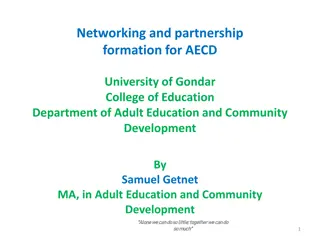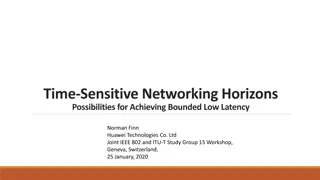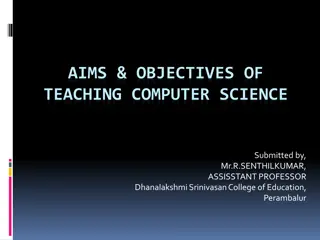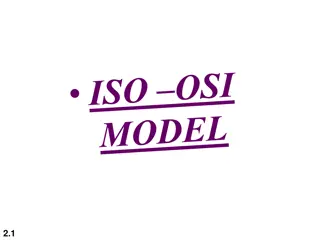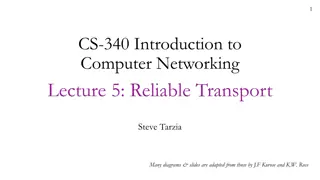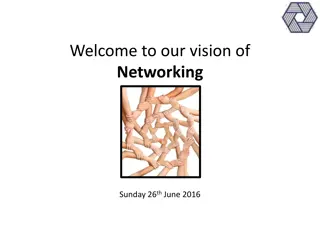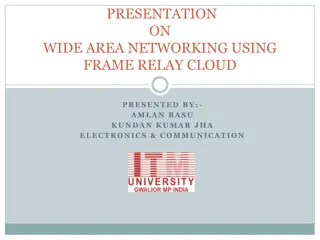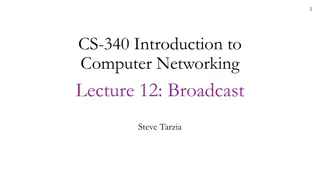
Understanding Transmission Media in Computer Networking
Explore the world of transmission media in computer networking, from guided to unguided options, including twisted pair cables, co-axial cables, fiber optics, and more. Discover how data travels through networks and the distinction between bound and unbound transmission media.
Download Presentation

Please find below an Image/Link to download the presentation.
The content on the website is provided AS IS for your information and personal use only. It may not be sold, licensed, or shared on other websites without obtaining consent from the author. Download presentation by click this link. If you encounter any issues during the download, it is possible that the publisher has removed the file from their server.
E N D
Presentation Transcript
COMPUTER NETWORKING Lesson #2 TRANSMISSION MEDIA By: Suresh Khanal For http://mcqSets.com
TOPICS: What is transmission media Types of transmission media Bound transmission media Unbound transmission media
Transmission media is the pathway through which data travels in a network. It can be guided as in cables or wires and also unguided transmission media such as in wireless transmission.
Cables used to connect the different nodes of network are also called bound transmission media as they are bound by physical geography.
Thus, for wireless connections, that are not bound by physical geography are called unbound transmission media
TYPES OF TRANSMISSION MEDIA 1. Bound transmission media or Guided transmission media Twisted Pair Cables Co-axial Cables Fibre Optics Cable 2. Unbound transmission media or Unguided transmission media Microwave Radiowave Infrared
BOUND TRANSMISSION MEDIA The type of media that is bound by physical geography such as cables are known as bound transmission media. Twisted pair cables, Co-axial cables, Fibre optics cables etc. are the examples.
TWISTED PAIR CABLES A pair of wires twisted with each other. The conductor (copper) is cover with insulator and 4 pairs of such are packed inside cable jacket to make a network cable.
DIFFERENT CATEGORY TWISTED PAIR CABLES https://www.linkedin.com/pulse/guide-choosing-suitable-ethernet-cables-kerry-zhang
RJ45 FOR TWISTED PAIR CABLES https://www.linkedin.com/pulse/guide-choosing-suitable-ethernet-cables-kerry-zhang
RJ45 PORTS
TYPES OF TRANSMISSION MEDIA 1. Bound transmission media or Guided transmission media Twisted Pair Cables Co-axial Cables Fibre Optics Cable 2. Unbound transmission media or Unguided transmission media Microwave Radiowave Infrared
CO-AXIAL CABLE A solid central conductor surrounded by insulating material and then by a cylindrical shield woven from fine wires is known as co-axial cable.
CO-AXIAL CABLE Co-axial cables are terminated with a connector known as BNC connector
FIBER-OPTICS CABLE A cable with central glass tube covered with protective shield which transmit data using photons is fiber optics cable. These cables transmit data via concentrated bursts of laser beams which are carried through bundles of hair thin glass fibers.
FIBER-OPTICS CABLE A cable with central glass tube covered with protective shield which transmit data using photons is fiber optics cable. These cables transmit data via concentrated bursts of laser beams which are carried through bundles of hair thin glass fibers.
FIBER-OPTICS CABLE Physical look of fiber optic cable terminated with SC connector
TYPES OF TRANSMISSION MEDIA 1. Bound transmission media or Guided transmission media Twisted Pair Cables Co-axial Cables Fibre Optics Cable 2. Unbound transmission media or Unguided transmission media Microwave Radiowave Infrared
UNBOUND TRANSMISSION MEDIA Unbound transmission media extend beyond the limiting confines of cabling. They provide an excellent communication alternative for WANS. The lack of physical restrictions provides larger bandwidth as well as wide area capabilities. Unbound media typically operate at very high frequencies. The three types of unbound transmission media are: Radio wave, Micro wave, Infrared
RADIO WAVE Radio waves makes it possible to connect to the network when running cables is difficult or more expensive. In wireless networking, air is the vehicle through which the data is carried, just as Ethernet uses copper cable
Credits: https://www.slideshare.net/SameerFarooq2/sameer-farooq RADIO WAVE
MICROWAVE Microwaves have been used in data communications for a long time. They have a higher frequency than radio waves and therefore can handle larger amounts of data. Microwave transmission is line of sight (LOS) transmission. The transmit station must be in visible contact with the receive station. This sets a limit on the distance between stations depending on the local geography. Typically the line of sight, due to the Earth s curvature, is only 50 km to the horizon! Repeater stations must be placed so the data signal can hop, skip and jump across the country.
INFRARED Infrared offers a great unbound photonic solution. Like fiber-optic cabling, infrared communications use light, so they are not bound by the limitations of electricity.







